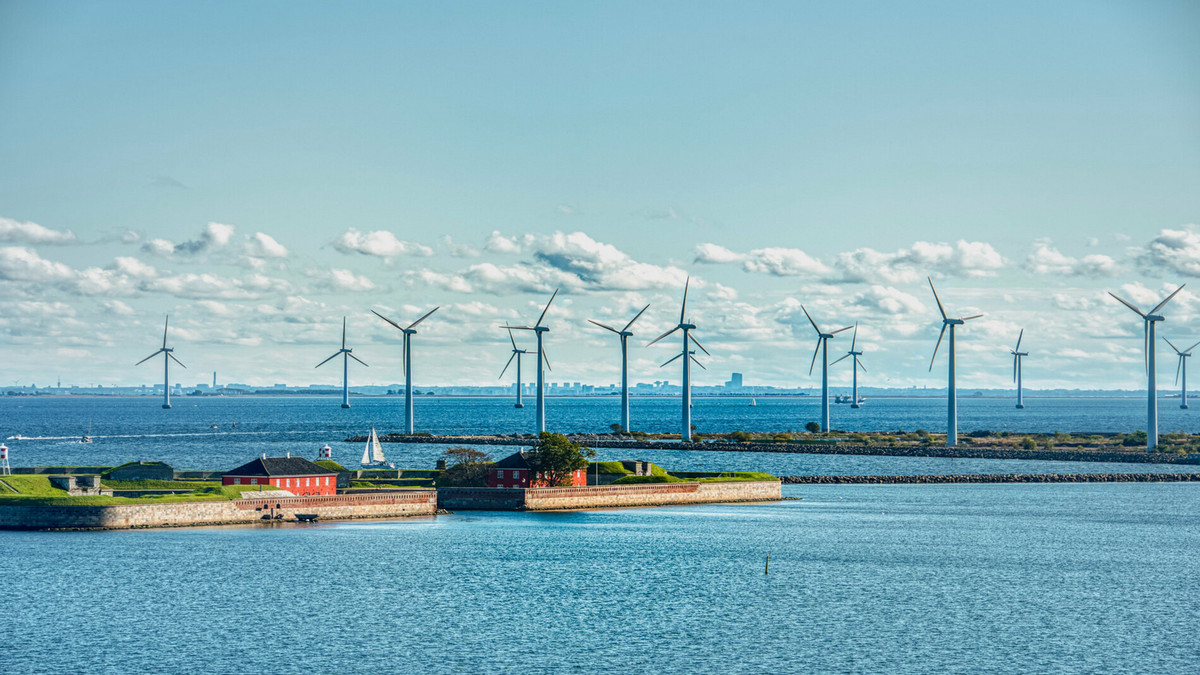The demand for renewable energy is increasing day by day. Facing the instability of wind energy and solar energy, energy digitization can increase the productivity and availability of green electricity, such as using algorithms and blockchain technology to reduce consumption and improve flexibility.
Global Energy Issues:
The problem of global warming is becoming more and more serious. Many international consensuses have been reached on energy conservation and emission reduction, and mitigation of irreversible disasters caused by climate change. In the IPCC report, the visible impacts of climate change, including a wide range of negative impacts, and related losses and damages to nature and human beings. At the same time, at the COP26 summit held at the end of 2021, countries also emphasized the urgency of promoting renewable energy, green transportation, and building construction to reduce the damage caused by climate change for millions of people.
With the development of science and technology and the popularization of the Internet, digital transformation and the digital revolution have become issues. That governments, enterprises, and even the people need to face together. How to use technology to bring empowerment to sustainability and create impactful business models while solving environmental problems. Therefore, combining climate action with digital tools may provide an effective solution. If the industry can properly introduce digital technology, it can not only assist enterprises in their net-zero strategy and effectively reduce carbon emissions from operations. And supply chains by up to 20%, but also play a role in large-scale green power and renewable energy infrastructure projects. The effect of cost reduction and efficiency increase.
Why Digitize Energy?
With the continuous increase in the capacity of global renewable energy installations, the solar and wind energy markets have grown significantly. Because of the instability of renewable energy power generation, a stable power supply can be achieved through energy storage equipment, extending energy storage business opportunities for homes, industries, and electric vehicles.
From the perspective of supply, the demand for renewable energy in major global markets is increasing. At the same time, various constraints, such as wind energy, instability of solar energy, iterative upgrade of battery energy storage, disposal of discarded solar panels, etc. Institutions are constantly developing solutions.
From the perspective of demand, human daily life covers all aspects of food, clothing, housing, transportation, recreation, and entertainment, and relies on energy-driven economic activities. Based on the rise of policy norms and sustainability awareness, companies and the public are facing paradigm shifts in terms of energy. Increase the use of renewable energy.
Internet technology and digital technology are also changing the global energy system. Digitization has promoted the advantages of a new generation of regional microgrids and decentralized energy system architecture. Technology can be used to manage energy in different regions, breaking the relatively inelastic divide between the supply and demand of traditional electricity. If cloud and AI technologies are properly introduced, electricity and computing power can be further combined to coordinate the combination of renewable energy and traditional power grids. To achieve better scheduling and promote energy transformation. Such as calculating the peak of solar power supply, pushing up the workload during this period, and other technologies. In the long run, it can assist countries and enterprises in their development path toward net zero carbon emissions. Fundamentally, the combination of energy and network technology is a new business model that breaks the past one-way transmission mode and connects scattered points to points. That is energy production, transmission, distribution, storage, consumption, and energy-related financial market, a new system of deep integration.
In the early stage, priority will be given to increasing the use of renewable energy, and through the coordinated supply of solar energy, hydropower, and other energy sources, to interact with the consumer side, because it is small-scale, and it is data-oriented and precise so that the needs of the public can be more widely involved in the use of energy. From an economic point of view, it is to seek Pareto efficiency among various parties, an ideal state of resource allocation, which will not improve the situation of others when anyone is damaged, and promote a higher quality of the overall energy system, efficient, fairer, sustainable, and safer to operate and use.
What can Energy Digitization do?
- Miniature grids reduce wear and tear:
When more and more proportions come from renewable energy, the establishment of distributed power stations and micro-grids based on communities or small-scale fields not only outperforms traditional power grids in terms of efficiency and stability but also improves the matching between supply and demand. It can highlight the advantages of distributed architecture and also have the opportunity to increase the productivity and availability of green electricity.
If energy is like the Internet platform, energy management and storage should be properly managed and stored during off-peak hours. During peak power consumption, centralized dispatching only needs to dispatch the changed part. Through the instant feedback from the demand side and the coordination of the source network, it can be used in the process. China can use new and renewable energy as much as possible to avoid many losses in the transmission process.
- Algorithms predict weather and power supply:
By combining the computing power of the multi-database to predict, it can alleviate the inconvenience of unstable power generation caused by the fluctuation of renewable energy due to unstable weather. In an ideal state, if multiple microgrids/power stations are connected in series with each other, consumers can even purchase solar and wind power in any place according to their living habits. Through distributed technology, supply and demand can be matched point-to-point, and flexible and customized pricing.
To achieve low-carbon living, and net zero goals, energy is a top priority. If it is said that energy is the necessary fuel to promote economic activities, the essence of digitalization is to find a new business model for transformation. And to cooperate with the upgrading of the energy industry, to compete for this business opportunity while taking into account the attempt at environmental sustainability.
- Decentralized applications improve resilience:
Due to the different relationship between regionality and natural conditions, each place will have different energy needs, which require customized solutions. Therefore, the development of small-scale, low-cost demand-oriented energy infrastructure such as distributed power stations and community microgrids is the focus of development. Especially in developing areas, as small as a community or an entire industrial park, as large as a city, a province, or the whole country, the above technology applications can be used to achieve centralized and distributed coordinated operation, load stability, and reduce grid regulation pressure.
- Reduce costs and bring carbon dividends:
In addition to production capacity, the user side can benefit from digitization during the usage phase. According to data provided by Schneider Electric, through its intelligent power distribution solutions and digitalization, customers in different industries can achieve up to 85% of energy-saving benefits, save more than 30% of operating costs, and promote productivity.
In addition, digitization can help production equipment, improve operational efficiency by up to 50% and reduce risk by 25%, which can effectively reduce carbon footprint and help the manufacturing industry meet increasingly stringent ESG-related norms. In addition, in addition to carbon reduction, it may generate carbon credit dividends. The emission reduction performance achieved due to energy saving or the use of green energy, under appropriate conditions, can be listed in the international carbon trading market through compliant third-party certification, and further convert it into income, so that there is a reasonable connection between environmental sustainability and corporate profitability.
Energy and Environment Micro Trends:
- Green hydrogen replaces fossil fuels, Europe, the United States, Japan, and South Korea are fully developed:
Electricity from industry to transportation and heating requires hydrogen. However, the current mainstream method of hydrogen production is to use fossil fuels such as methane and petroleum, which will produce a large number of carbon emissions. The hydrogen obtained from this is also called gray hydrogen. To this end, countries in Europe, America, Japan, and South Korea have started research on how to replace fossil fuels with renewable energy, electrolyze water to produce hydrogen, and convert gray hydrogen into green hydrogen.
- Floating offshore wind turbines, the focus of wind power promotion in the next stage:
After Denmark completed the world's first offshore wind farm in 1991, European manufacturers accumulated rich technologies and experience in building wind farms. However, in the past 30 years, the development of offshore wind farms near shore (within 20 kilometers offshore) has become increasingly saturated. Therefore, the development of FOWT (Floating Offshore Wind Turbine) technology that extends 20 to 30 kilometers offshore and has a water depth of more than 50 meters become the focus, and countries are included in the development goals.
- Nuclear fusion power generation makes great strides:
Compared with traditional nuclear power generation, nuclear fusion power generation has less radioactive pollution and no carbon emissions. However, to achieve nuclear fusion power generation, the core temperature of the reactor must exceed 100 million degrees Celsius, which is six times hotter than the core of the sun.
- The development potential of geothermal power generation:
Compared with wind energy and solar energy, which depend on the change of the weather, there is the problem of intermittent power generation. The geothermal energy stored in the ground can generate electricity 24 hours a day, and it will not emit carbon in the process, so it has great potential for development.
- Perovskite solar cells, which are more energy efficient than silicon:
Taiwan has a small land area and few roofs, and the number of solar panels that can be installed is limited. In addition, the current mainstream solar panel material is silicon, and the energy conversion efficiency limit is 20%, which further limits the prospect of solar power generation. perovskite technology has the advantages of a low-temperature process, light and thin materials, etc. The most important thing is that the energy conversion efficiency exceeds 25%, which is expected to accelerate the commercialization of PSC (Perovskite solar cell).
- Aerial water intake technology is expected to alleviate the water shortage crisis:
The Isothermal high-efficiency water-gas separation technology developed by the Taiwan Industrial Technology Research Institute is the world's first technology to produce clean water through the air. This technology uses a special graphene oxide film to extract water from the air, and it can be introduced into areas with insufficient water sources in the future. When this technology is installed on the roof of a home, as long as the air sweeps through the membrane, it can produce clean water and effectively relieve the water situation.
- Recycling waste creates value again:
International brands have increased demand for raw materials in the circular economy. In the future, the casual clothes and sports shoes you wear may be made of carbon waste gas and marine waste plastic. Polyester fibers have been developed for recycling industrial waste gas.
- Direct air capture technology to bury carbon dioxide underground:
If you want to reduce carbon emissions, directly sucking carbon from the air may be the most powerful means. Direct air capture (DAC) technology uses a fan to extract air and uses a liquid solvent or solid sorbent filter to collect carbon dioxide, which can be stored in the ground or converted into raw materials for making plastics. Although DAC is only a temporary solution, it is still an important supporting measure for countries to move towards net zero emissions.
- The AI model opens up user connections, eliminating the power consumption of re-development:
Technology is advancing rapidly, but everything from cryptocurrency mining to AI model training consumes a lot of electricity. The language model GPT-2 of the non-profit artificial intelligence research organization Open AI has a carbon emission of 2.8 million tons, equivalent to the lifetime emissions of five cars. To the development of technology and reduce carbon emissions, Open AI directly uses the trained AI model and opens up APIs for users to connect to the application, without the need to train the AI model from scratch. Google is using AI for energy saving and carbon reduction, such as optimizing traffic lights through AI, reducing traffic congestion, and using AI to manage machines to improve the energy efficiency of data centers.
- Energy storage brick, which can be recharged 10,000 times:
The bricks used to build the house will also store electricity in the future. Using the porous properties of bricks, the conductive plastic nanofibers that can store electric charges are filled into the pores, which can be recharged 10,000 times. In the future, when solar panels are installed in buildings, the generated electricity can be stored in energy storage bricks, but the energy density has yet to be broken through.
- Save electricity and sell it, it can become a virtual power plant:
As houses begin to install energy storage devices such as solar panels, Virtual power plants (VPP), which can integrate power resources, will drive new business models. The aggregator can integrate the electricity consumption behaviors of several users, negotiate electricity price plans with power companies, and give back to the users below to reduce electricity consumption. The user group represents the need to control the equipment of the power users to help the power company overcome peak power consumption. At the same time, it is avoided that after the regulation is over, a large number of users start the air conditioners at the same time, which will cause another wave of power consumption peaks, resulting in a retaliatory power consumption effect. In the future, through the introduction of AI algorithms, electricity consumption scheduling will also be done.
- Energy storage, electric vehicle power, join the free trading market:
The Taiwan government has opened up the free sale of green electricity, and many private renewable energy sales businesses have been established. In the past, Tai power had the final say on how much electricity was used, but through blockchain peer-to-peer technology, electricity settlement can be made more transparent and clearer, and the problem of information asymmetry can be solved. Future electricity trading will not only include electricity from renewable energy sources, but also electricity from energy storage devices and electric vehicles. With the growth of electric vehicle sales, the government intends to develop a special electricity tariff for electric vehicles and manage the charging behavior of electric vehicles, which will bring new business models.
- Building materials can repair cracks by themselves:
The construction industry has always been a major contributor to carbon emissions. Most cement manufacturers have introduced carbon capture, utilization, and storage (CCUS) technology to improve carbon emissions in the process. Scientists have developed a new type of living building material, which combines gel and live bacteria through the sand to develop a self-healing building material that is more environmentally friendly than cement. Although the strength is not comparable to traditional cement, the living bacteria can be damaged when the wall is damaged. Repair cracks yourself.
Looking to the future of Energy Digitization:
As the cost of renewable energy power generation decreases year by year, the IEA predicts that in 2024, renewable energy will surpass coal and become the world's largest source of power generation, providing one-third of the world's electricity. Businesses and individuals can more easily participate in the use of renewable energy.
In the foreseeable future, not only the energy industry but all industries that use energy will undergo digital reforms. Energy has changed from producers to producers and sellers, and the energy production mode has also changed from one-way flow production in the past (power generation-distribution-transmission-electricity). In the future two-way, multi-source, real-time interaction, demand-oriented, decentralization, and collaboration-based energy Internet ecology. That is, the full integration of electricity + computing power, and year by year, the entire industry will be improved in green energy, and renewable energy The proportion of the use of, digital technology, is to achieve net zero sustainability.





.jpg)








